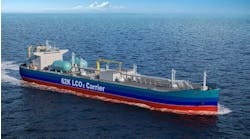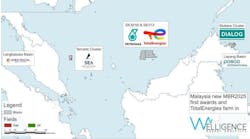Nick Terdre, Contributing Editor
Next year should be memorable for Norway’s offshore sector, with start-up of both the giant Ormen Lange field, with reserves of 397 bcm, and Snøhvit, with 164 bcm. By 2010, annual exports will rise to 100 bcm, and in the following years, further planned developments could boost this to 120 bcm.
However, if the country is to fulfill its declared intention of becoming a reliable, long-term gas exporter, new sources will have to be found, matured, and developed. According to Ståle Thorsen, senior adviser at the Norwegian Petroleum Directorate (NPD), from around 2016 a growing contribution must come from new fields, including undiscovered resources.
At present there are no fields which compare with Ormen Lange or with Snøhvit. Tyrihans, which was approved for development earlier this year, is due onstream in 2009 with an estimated 35 bcm. Skarv and Idun, a joint development expected onstream in 2010, have combined reserves of 48 bcm and Gjøa, also a likely 2010 start-up, 35 bcm.
Beyond these, most of the significant untapped discoveries lie under the Norwegian Sea. But much appraisal work is needed to establish if they are economical. “We have no mature gas finds in the Norwegian Sea,” says Thorsen. “The existing portfolio consists mainly of smaller or immature fields.”
One discovery which does stand is Victoria, in the northern Halten Bank, found by ExxonMobil in 2000. The NPD estimates its reserves at 118 bcm, but also places it in the category of “finds where production is likely, but not yet clarified.” Reservoir conditions are extreme, with very high temperatures and pressures. Earlier this year Total agreed to acquire ExxonMobil’s stake, and is seeking operatorship. According to Thorsen, a couple of appraisal wells may be drilled by 2010.
The next largest find is Luva, or Nyk High as it was called when BP discovered it in 1997. In the Vøring basin, it has estimated reserves of 38 bcm, one third of Victoria’s. Statoil, which is taking over BP’s stake and operatorship, plans an appraisal well in 2007 or 2008.
Last year on the southwest flank of the Halten Bank, Shell discovered Onyx Southwest, where the NPD estimates reserves to be 33 bcm. This year, Shell plans an appraisal well and a wildcat on another prospect on the same license. Onyx lies around 40 km south of Statoil’s Kristin Field. Another 2005 find was Hydro’s Stetind, roughly 100 km southwest of Luva. The NPD’s reserves estimate is 29 bcm.
There are several smaller gas accumulations, such as Statoil’s Tulipan, discovered last year in the southwest reaches of the Norwegian Sea around 130 km west of Ormen Lange in a water depth of 1,262 m. Reserves are small - no precise figure is available - but the find was made on the basis of a new play model, which could prove interesting for further exploration, Thorsen says.
Interconnection issues
As for development, the Norwegian Sea throws up many challenges, including a harsh climate and deeper waters, and many of the fields lie remote from existing infrastructure. At some point, therefore, a new pipeline several hundred kilometers long will be needed to connect with the transport network in the North Sea.
Luva is an example of the challenges. It is 100 km north of Norne, Norway’s northernmost producing field, in a water depth of 1,300 m, substantially deeper than Ormen Lange, the deepest field developed in the Norwegian sector.
The NPD has a role working with individual licenses to ensure a coordinated approach to development is taken where appropriate, and identifying a critical mass of potential field developments which could share the cost of a new pipeline, Thorsen says.
In addition to the confirmed discoveries, the NPD calculates there are some 810 bcm of gas resources to be discovered in the Norwegian Sea. Turning this potential into proven reserves is another matter, but after several years of relatively low activity, the exploration effort is gathering pace. According to Benvenutta Henriksen, senior economist at the NPD, there are up to five exploration and appraisal wells planned both this year and next in the northern Halten Bank, plus several further south.
This year and 2007 also should see wells in the Vøring basin and the Møre region in the southern Norwegian Sea. In addition, there are about seven 17th and 18th round licenses subject to drill-or-drop decisions before 2010, says Henriksen. Exploration also will receive a boost from the seven new Norwegian Sea licenses awarded in the 19th round earlier this year, involving a total of four committed wells.
| Name | Operator | Discovery well | Date of discovery | Reserves (bcm) |
|---|---|---|---|---|
| Hvitveis | ExxonMobil | 6706/6-1 | 2003 | -- |
| Luva | Statoil | 6707/10-1 | 1997 | 38 |
| Onyx | Shell | 6406/9-1 | 2005 | 33 |
| Stetind | Norsk Hydro | 6605/8-1 | 2005 | 29 |
| Tulipan | Statoil | 6302/6-1 | 2005 | 1.8 |
| Victoria | Total | 6506/6-1 | 2000 | 118 |




